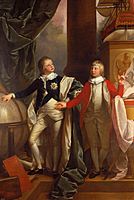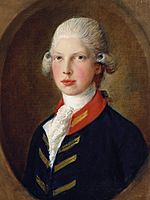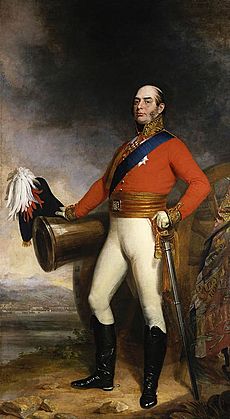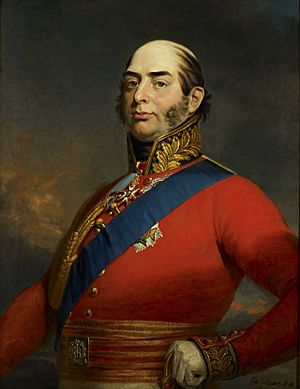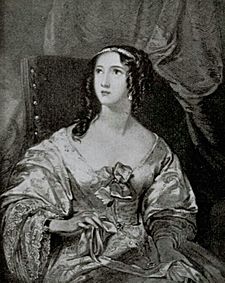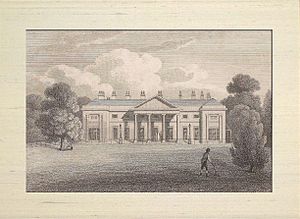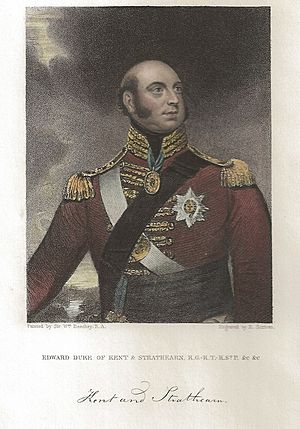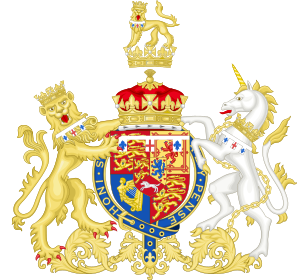Prince Edward, Duke of Kent and Strathearn facts for kids
Quick facts for kids Prince Edward |
|||||
|---|---|---|---|---|---|
| Duke of Kent and Strathearn | |||||

Portrait by Sir William Beechey, 1818
|
|||||
| Born | 2 November 1767 Buckingham House, London, England |
||||
| Died | 23 January 1820 (aged 52) Woolbrook Cottage, Sidmouth, England |
||||
| Burial | 12 February 1820 Royal Vault, St George's Chapel, Windsor Castle |
||||
| Spouse | |||||
| Issue | Victoria, Queen of the United Kingdom | ||||
|
|||||
| House | Hanover | ||||
| Father | George III | ||||
| Mother | Charlotte of Mecklenburg-Strelitz | ||||
| Military career | |||||
| Allegiance | |||||
| Service/ |
|||||
| Years of active service | 1786–1805 | ||||
| Rank | Field marshal (active service) |
||||
| Unit | 7th Regiment of Foot (Royal Fusiliers) | ||||
| Commands held | |||||
| Battles/wars | |||||
| Awards | Mentioned in dispatches | ||||
Prince Edward, Duke of Kent and Strathearn (born Edward Augustus; 2 November 1767 – 23 January 1820) was the fourth son of King George III. He is most famous for being the father of Queen Victoria, who ruled the United Kingdom for many years.
Prince Edward was given the titles of Duke of Kent and Strathearn and Earl of Dublin in 1799. He was also a high-ranking military officer, serving as a General and later a Field-Marshal. He was the commander-in-chief of British forces in North America.
He was the first member of the British royal family to live in North America for a long time (1791–1800). He even visited the United States in 1794. He is known for using the word "Canadian" to describe both French and English settlers in Canada in 1792. Today, some call him the "Father of the Canadian Crown" because of his influence on Canada's early development.
Contents
Early Life
Prince Edward was born on 2 November 1767. His parents were King George III and Charlotte of Mecklenburg-Strelitz.
He was fourth in line to the throne. He was named after his uncle, the Duke of York and Albany, who had passed away a few weeks before Edward's birth. Edward was baptized on 30 November 1767.
-
Edward aged eleven (right) and his older brother William, portrait by Benjamin West, 1778
-
Prince Edward in 1782, portrait by Thomas Gainsborough
Military Career
Early Army Service
Prince Edward started his military training in Hanover in 1785. He was appointed a colonel in the British Army in 1786. From 1788 to 1789, he finished his education in Geneva.
In 1789, he became the colonel of the 7th Regiment of Foot (Royal Fusiliers). In 1790, he returned home without permission and was sent to Gibraltar as a punishment.
Service in Canada
Because of the hot weather in Gibraltar, Edward asked to be moved to Canada in 1791. He arrived in Quebec and became the first member of the Royal Family to visit Upper Canada. He became an important figure in British North American society.
Edward was promoted to major-general in 1793. He fought in the West Indies campaign the next year. He was praised for his "great Spirit and Activity" during the Battle of Martinique.
After 1794, Prince Edward lived in Halifax, Nova Scotia. He helped build up the city's military defenses and protect its important Royal Navy base. He also influenced the city's social and economic life. Edward was responsible for building Halifax's famous Garrison Clock.
In 1799, Prince Edward was made Duke of Kent and Strathearn and Earl of Dublin. He was also promoted to general and became the Commander-in-Chief of British forces in North America.
Governor of Gibraltar
In 1802, the Duke was appointed Governor of Gibraltar. His job was to bring discipline to the soldiers there. However, his strict rules led to a mutiny (a rebellion by soldiers) on Christmas Eve. His brother, Frederick, the Duke of York, ordered him to return to England in 1803.
Even though he was still the Governor of Gibraltar until his death, he was not allowed to return there. As a comfort for the end of his active military career, he was promoted to field marshal in 1805.
The Duke was known for being very strict, but he also cared about his soldiers. He started the first regimental school for them. He supported social changes like Catholic emancipation and was interested in new ideas.
Personal Life and Family
Marriage and Succession
In 1817, Princess Charlotte of Wales passed away. She was the only grandchild of King George III at the time. This made the future of the royal family uncertain because many of the King's sons did not have children who could inherit the throne.
To ensure there would be an heir, several of the King's unmarried sons, including Edward, decided to get married.
Princess Victoria of Saxe-Coburg-Saalfeld
The Duke of Kent, who was 50 years old, became engaged to Princess Victoria of Saxe-Coburg-Saalfeld. She was the sister-in-law of his niece, Princess Charlotte, who had recently died. They were married in Germany in May 1818 and again in England in July 1818.
Princess Victoria was a widow and already had two children from her first marriage: Karl and Feodora.
Birth of Queen Victoria
The Duke and Duchess of Kent had one child together, a daughter named Princess Alexandrina Victoria of Kent. She was born in May 1819.
The Duke was very proud of his daughter. He often told his friends to look at her carefully, saying that she would one day be Queen of the United Kingdom. His prediction came true when his daughter became Queen Victoria in 1837.
Personal Relationships
Before his marriage, Prince Edward had several relationships. In Geneva, he had two companions, Adelaide Dubus and Anne Moré, with whom he had children.
Later, in 1790, he began a long-term relationship with Thérèse-Bernardine Montgenet, known as "Madame de Saint-Laurent". She traveled with him to Canada in 1791 and stayed with him for 28 years until his marriage in 1818. Research has shown that they did not have any children together.
Canadian Connections
While living in Quebec (1791–1793), Prince Edward met Jonathan Sewell, an American Loyalist. Sewell later became an important government official in Canada. In 1814, Sewell shared his idea for uniting the British provinces in North America with the Duke.
Prince Edward supported Sewell's plan to bring the colonies together. His comments and ideas were later used by important figures like Lord Durham and at the Charlottetown and Quebec Conferences in 1864, which led to the creation of Canada.
Freemasonry
Prince Edward was involved in Freemasonry, a fraternal organization. In 1813, his brother, Prince Augustus Frederick, Duke of Sussex, became the Grand Master of one major Masonic group in England. In December of that same year, Prince Edward became the Grand Master of another major Masonic group.
These two groups worked together to form the United Grand Lodge of England on 27 December 1813. Prince Edward's younger brother, the Duke of Sussex, became the Grand Master of this new, united organization.
Later Life and Death
In 1801, the Duke of Kent bought a house called Castle Hill Lodge in Ealing, West London. He spent a lot of money renovating it.
After his daughter Princess Victoria was born in 1819, the Duke and Duchess needed to save money because of the Duke's large debts. They decided to live in a less expensive place. They leased Woolbrook Cottage in Sidmouth, on the coast of Devon.
Death
The Duke of Kent passed away from pneumonia on 23 January 1820 at Woolbrook Cottage. He was buried in St. George's Chapel at Windsor Castle. He died just six days before his father, King George III, and less than a year after his daughter Victoria was born.
Even though he died before his father and his three older brothers, none of his older brothers had any surviving legitimate children. This meant that his daughter Victoria became Queen when her uncle King William IV died in 1837. She ruled until 1901.
The Duke's debts were eventually paid off by his daughter Victoria after she became Queen.
Legacy
There is a bronze statue of Prince Edward in Park Crescent, London. It was made by Sebastian Gahagan and put up in 1824. The statue shows the Duke in his Field Marshal's uniform.
Several places are named after him, including Prince Edward Island in Canada, the Prince Edward Islands, and Prince Edward County in Ontario. Duke Street in Halifax, Nova Scotia is also named in his honor.
Titles, Styles, Honours and Arms
Titles and Styles
- 2 November 1767 – 24 April 1799: His Royal Highness The Prince Edward
- 24 April 1799 – 23 January 1820: His Royal Highness The Duke of Kent and Strathearn
Honours
- Knight Founder of St. Patrick, 11 March 1783
- Royal Knight of the Garter, 2 June 1786
- Privy Councilor of the United Kingdom, 5 September 1799
- Knight Grand Cross of the Bath (military), 2 January 1815
- Knight Grand Cross of the Royal Hanoverian Guelphic Order (military), 12 April 1815
Arms
As a son of the King, the Duke of Kent used the royal coat of arms. His arms had a special design to show he was a son of the monarch.
|
See also
 In Spanish: Eduardo de Kent (1767-1820) para niños
In Spanish: Eduardo de Kent (1767-1820) para niños


